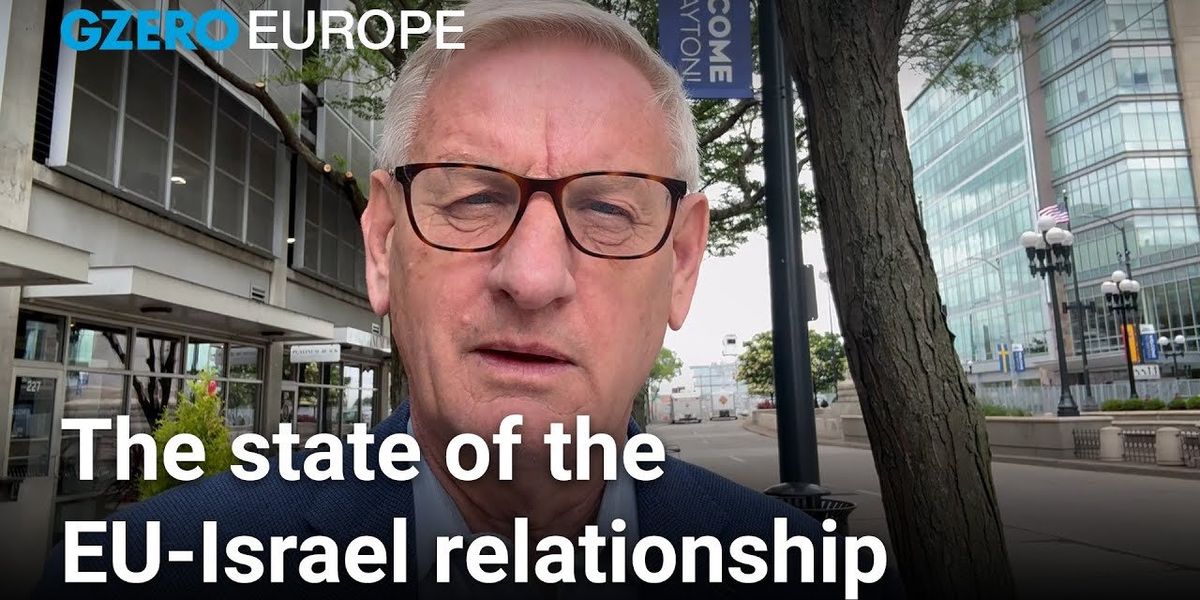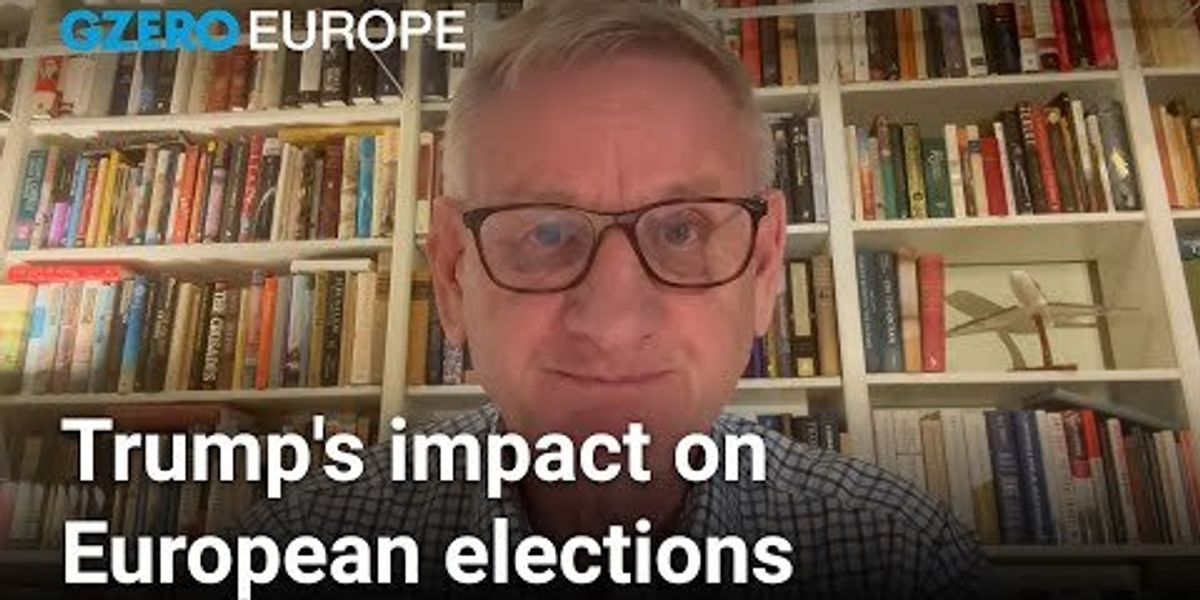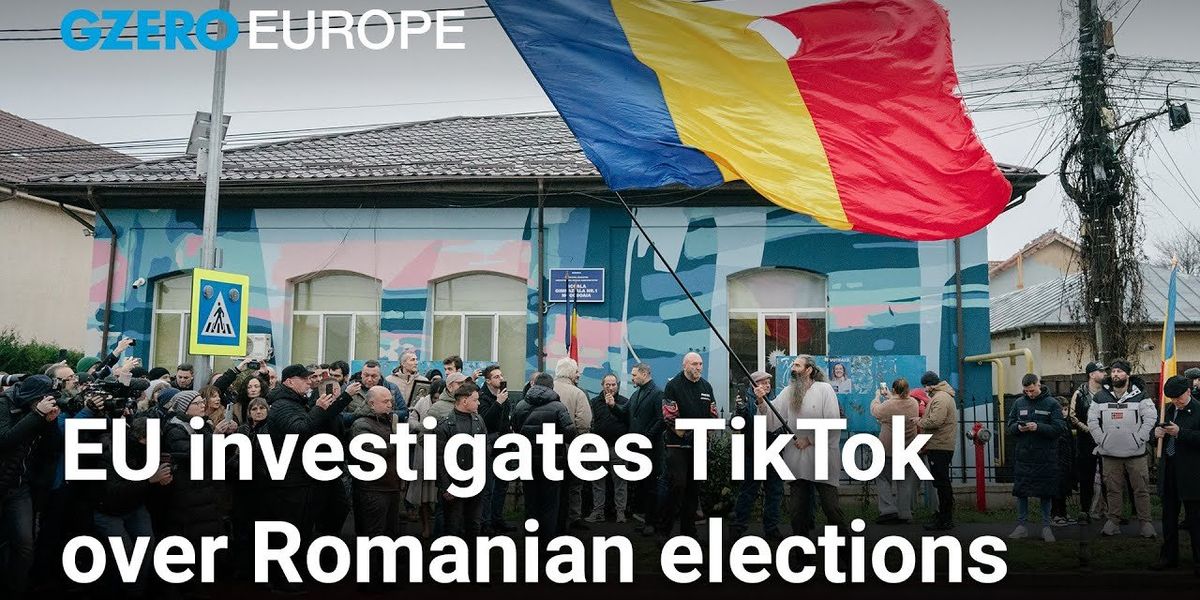Trending Now
We have updated our Privacy Policy and Terms of Use for Eurasia Group and its affiliates, including GZERO Media, to clarify the types of data we collect, how we collect it, how we use data and with whom we share data. By using our website you consent to our Terms and Conditions and Privacy Policy, including the transfer of your personal data to the United States from your country of residence, and our use of cookies described in our Cookie Policy.
{{ subpage.title }}
EU pressures Israel over Gaza, Romania surprises, Poland vote ahead
In this episode of Europe In 60 Seconds, former prime minister of Sweden Carl Bildt checks in from Dayton, Ohio, with sharp insights on two key developments: The EU’s decision to review its association agreement with Israel amid mounting criticism of Israeli actions in Gaza and the West Bank, and a surprise turn in Romania’s presidential race where a centrist victory defied populist expectations.
Plus, all eyes turn to Poland for a critical second-round election on June 1. What’s at stake for Europe’s political future?
An Iranian newspaper with a cover photo of US President Donald Trump and US Middle East envoy Steve Witkoff, is seen in Tehran, Iran, on May 11, 2025.
What We’re Watching: US and Iran near mini-deal, Europe election extravaganza, Diss tracks at Eurovision
US and Iran edge toward “mini-deal” on nukes
US President Donald Trump said Thursday that the US and Iran have “sort of” agreed on terms for a nuclear deal, one day after a top Iranian adviser said Tehran is willing to eliminate weapons-grade uranium, limit enrichment, and allow international inspections — if sanctions are lifted immediately. But dismantling their nuclear program or ability to enrich uranium, as per the Iran nuclear deal negotiated in 2015, is off the table.
“While a full-scale deal like the [2015 deal] appears unlikely, both sides are showing interest in a limited ‘mini-deal’ that reduces tensions and creates more space for diplomacy,” says Eurasia Group Iran expert Gregory Brew. “A win for Trump and for his new friends in the Gulf.”
Election extravaganza: Big weekend for Europe
There will be a trio of elections on the continent this Sunday. Here’s a quick roundup of who’s voting and where.
Poland: The first round of the presidential election takes place this weekend, pitting Warsaw Mayor Rafał Trzaskowski, a centrist, against the right-wing Law and Justice leader Karol Nawrocki. The election will be a harbinger of Poland’s alignment with the European Union at a vital time for the bloc. Polls have Trzaskowski ahead, but well short of 50%, which means there will likely be a runoff between the two front-runners on June 1.
Portugal: The Iberian nation is holding its third election in as many years, leaving some of the electorate fed up with its stagnant government. Polls suggest the situation isn’t about to get better: Prime Minister Luis Montenegro’s center-right Democratic Alliance is ahead but doesn’t have enough support to gain a working majority.
Romania: Of all the elections this weekend, it’s the one in Bucharest that is garnering the most attention, after the Romanian Constitutional Court barred nationalist candidate Călin Georgescu from running over allegations of Russian meddling. George Simion has filled Georgescu’s shoes and will seek to triumph over the pro-EU candidate Nicusor Dan. With polls tied, the race is on a knife-edge.
At Eurovision 2025: Glitter, geopolitics, and a sauna diss track
Europe’s glitter-soaked, pyrotechnic-powered music competition fever dream — otherwise known as the Eurovision Song Contest — takes place Saturday at 9 p.m. CET (3 p.m. ET). It’s part talent show, part geopolitical popularity contest, and fully unhinged fun.
Unlike in the past two years, politics is taking a relative back seat this time around. However, there are two diss tracks. Sweden’s “Bara Bada Bastu” — the odds-on favorite — roasts Finland’s love of saunas, while Estonia’s viral “Espresso Macchiato” mocks Italian language and American work culture. Mamma mia!How will the Trump presidency influence elections in Europe?
Carl Bildt, former prime minister of Sweden and co-chair of the European Council on Foreign Relations, shares his perspective on European politics from Stockholm, Sweden.
How do you believe that the Trump presidency will influence elections in Europe?
Well, of course we don't know. But what we've seen during the last week with important elections in Canada and Australia, not Europe, but fairly similar in other ways, is that the Trump factor has been very important. It has boosted the incumbent governments. It has boosted the center-left. It has boosted those who are seen as standing up to American pressure, and thus produced results both in Canada, primarily in Canada, but also in Australia. Very different from what practically everyone expected a couple of months ago.
Europe, different place. But still we have two important elections coming up, within slightly more than 10 days. We have the first round of the presidential election in Poland. That's very important for the future possibilities of the Tusk government to continue reforming that particular country. And we have the second round of the presidential election in Romania. An important country often forgotten. But there of course, we had gross interference from Russia and TikTok, and a candidate was banned. In both of these cases, we see the Trump presidency acting. They received, in the White House the other day, the opposition candidate. The extreme right nationalist opposition candidate the other day. And they've been making distinct noises in favor of the same political alternative in Romania. Will this backfire in the way it did in Canada, Australia? Remains to be seen. Very important elections both of them. Watch this space.
A boy holds a sign reading "Calin Georgescu President" during an anti-government rally in Bucharest, Romania.
Romania’s leading presidential candidate appeals ban
Georgescu has appealed his exclusion.
The background: Last year, Georgescu – a once-fringe figure – won the first round of the presidential election after an 11th-hour flood of TikTok videos boosted his views: He opposes NATO’s help for Ukraine and admires Romania’s 20th-century fascist leaders. Authorities blamed a Russian influence campaign, without providing clear evidence, and canceled the results.
Why it matters: Foreign policy is one area where Romania’s mostly ceremonial presidency has real power. Romania, a NATO member, borders Ukraine and is a key piece of the alliance’s support for Kyiv.
Georgescu’s ban drew sharp reactions. Hundreds of his supporters clashed with police in Bucharest, and even Georgescu’s main opponent, pro-NATO candidate Elena Lasconi, who called the election annulment “an affront to the very essence of democracy,” has spoken out against the ban.
What’s next: Romania’s Constitutional Court will rule on the appeal by Wednesday.
The bigger question: Is it OK for a democracy to ban a leading candidate in the name of … democracy?
Romanian far-right presidential election candidate Calin Georgescu delivers a press statement at the Bucharest Court of Appeal, in Bucharest, Romania, on Dec. 19, 2024.
What to do with Romania’s Georgescu?
Last November, a Romanian election generated shock headlines across Europe when an obscure pro-Russia, anti-vaccine populist named Călin Georgescu finished first in the initial round of voting. Authorities determined that his rise to sudden prominence was fueled by a well-financed, slickly produced campaign on social media platform TikTok – and they blamed the Russian government, so far without proof, for funding it.
The Romanian government then annulled the election result, drawing criticism from US Vice-President JD Vance during a controversial speech earlier this month on threats to democracy in Europe.
But Romanian authorities face a problem: They’ve annulled the election but haven’t yet found a way to annul Georgescu’s candidacy for the election re-run scheduled for May. Now that he is no longer obscure, he may not need alleged Russian backing to win.
On Wednesday, Georgescu was taken into custody by police as part of an investigation into possible violations of an anti-extremism law. His detention makes clear that over the next three months, Romania will be on the frontlines of the fight between hard-right populists and political establishments, many of them unpopular, across Europe.
Romanian far-right presidential election candidate Calin Georgescu delivers a press statement at the Bucharest Court of Appeal, in Bucharest, Romania, December 19, 2024.
Romania’s Ciolacu comes back following TikTok turmoil
The vote puts a pause – for now – on the political drama that ensued following the first round of presidential elections December 1. Five days later, Romania’s constitutional court annulled the vote on evidence that Russia manipulated TikTok to boost the candidacy of little-known far-right candidate Calin Georgescu.
While Ciolacu’s Social Democratic party topped the parliamentary vote in that election, he came in third in the presidential vote and was eliminated as a presidential candidate and stepped down as leader. The tainted presidential contest must now be rerun, likely in the spring. Ciolacu’s new coalition will field a joint candidate, retired liberal politician Crin Antonescu.
What’s on Ciolacu’s agenda? Romania’s new government faces severe fiscal challenges. The national budget deficit is projected to top 8.5% of GDP, threatening a credit downgrade to junk status. Ciolacu has pledged to stabilize the economy and rebuild investor confidence, but austerity measures could fuel support for extremists ahead of next year’s vote.
We’re also watching for more allegations of Russian interference, and whether the court’s annulment changes the rest of the presidential election in the spring.
Why is TikTok being investigated by the EU over Romania's elections?
Carl Bildt, former prime minister of Sweden and co-chair of the European Council on Foreign Relations, shares his perspective on European politics from Northern Italy.
Why is the EU investigating TikTok over the elections in Romania?
Well in the first round of the Romanian presidential elections, there were suddenly, just days before the election, over 25,000 TikTok accounts that suddenly appeared. And they seemed to be supporting, very heavily, the rather sudden far-right candidate who had quite a result in that particular election that has subsequently been annulled. So it makes sense to investigate what really happened and who was behind it.
What is the new French prime minister doing in order to resolve the political crisis of the country?
Early days. He hasn't even presented his government as of yet. But I would guess that he will try to have a dialogue both with the elements of the moderate left and the moderate right to see if he can get a budget through. He is an experienced operator on the French political scene. Perhaps less determined in terms of policies than Michel Barnier was, but let's see. I think he'll present his policy program by mid-January, and there we'll be able to judge somewhat more clearly what prospects he has.
- In historic first, Romania annuls election over claims of TikTok interference ›
- Be very scared of AI + social media in politics ›
- TikTok is the ultimate propaganda tool, says tech expert Scott Galloway ›
- Macron has put France’s fate in Le Pen’s hands ›
- What France's government collapse means for Macron and Europe ›
Press conference about Romania and Bulgaria, former Soviet Bloc countries becoming EU members.
Romania and Bulgaria will join the border-free Schengen area
For Romania and Bulgaria, former Soviet Bloc countries that are now EU members, the light finally changed from red to green on Thursday as EU interior ministers agreed to let the two countries fully join the border-free Schengen zone on Jan. 1.
The Schengen area is a zone within which all are free to travel across national borders without stops or inspections. Its members include most EU countries, except for Cyprus and Ireland, as well as non-EU states Iceland, Norway, Switzerland, and Liechtenstein.
For the two incoming members, there will still be a few temporary restrictions on trucks crossing their borders, but these too will likely ease within months. The two countries had already been allowed internal air and sea borders without checks since March 2024, but this latest decision clears the way for free movement across internal land borders.
The decision is the result of a unanimous European Council vote of all member states, and it’s a big victory for Romanians and Bulgarians who favor deeper integration with Europe for either personal or commercial reasons.
For Romania, in particular, the timing carries particular symbolism. In recent days, the country’s constitutional court invalidated a national election following charges of election interference by Russia in favor of pro-Russian, anti-EU candidates.


